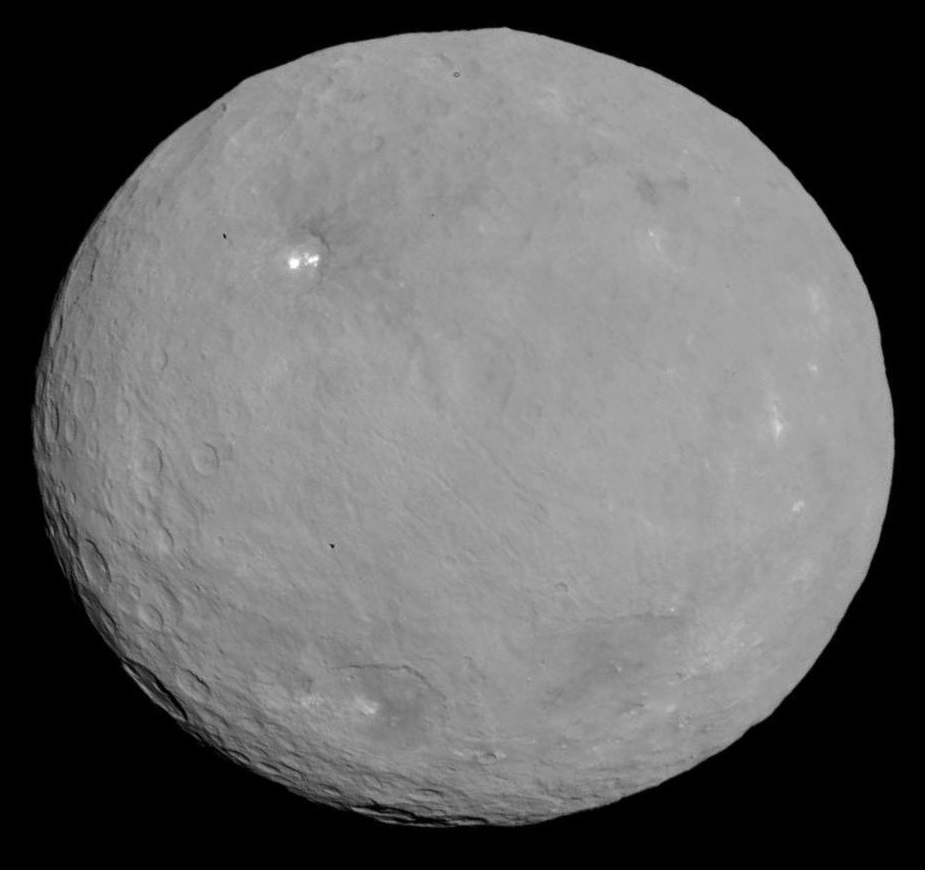
Caption: "PIA19562: Dawn RC3 Image 19. This image of Ceres ⚳ is part of a sequence taken by NASA's Dawn spacecraft (2007--2018) on 2015 May05--May06 from a distance of 13,600 km (∼ 28.8 Ceres radii)." (Slightly edited.)
Features:
- Ceres ⚳
was first asteroid.
It was discovered
1801 Jan01 by
Guiseppe Piazzi (1746--1826)
at the Palermo Observatory
in Sicily and named
Ceres for the
Roman goddess Ceres, the
goddess of the
harvest---from her name, we get
cereal---and "whose
earthly home, and oldest temple,
lay in Sicily"
(Wikipedia: Ceres:
Middle Republic;
Wikipedia: Ceres: Name).
- Ceres facts:
- Astronomical symbol:
: Probably a stylized scythe, appropriate for Ceres (mythological, the Roman goddess of the agriculture, harvest, cereals, etc..
- Mean orbital radius: 2.7675 AU.
- Eccentricity: 0.075823.
- Orbital period: 1681.63 days = 4.60405 Julian year.
- Sidereal rotation period: 0.3781 days = 9.074 hours prograde (i.e., eastward as seen on the sky and rightward in the image???. The rotation axis is the top to bottom??? and it is tilted by 4° from the ecliptic axis.
- Mean radius: 473 km.
- Dimensions: (965.2 x 961.2 x 891.2) ± 2.0 km. So Ceres is pretty round, but is definitely a bit oblate due to the centrifugal force.
- Oblateness f = (a-b)/a = 0.07475, where a is equatorial radius and b is polar radius.
- Mass: 9.393(5)*10**20 kg = 0.00015 Earth masses = 0.0128 Moon masses.
- Astronomical symbol:
- Ceres
seems to be a typical airless
rocky body:
lots of impact craters
mainly from the
heavy bombardment
and surface pounded down and smoothed to regolith by
space weathering and
diurnal temperature cycle weathering.
- Ceres may be 25 %
water ice by mass
(see NASA: Ceres: In Depth;
Wikipedia: Ceres:
Internal structure).
The water ice is mostly subsurface.
The large water ice component accounts for Ceres' relatively low density: 2.161(9) g/cm**3.
- Ceres has
bright spots
that are probably a relatively high albedo
salt
(see Wikipedia:
Ceres (dwarf planet): Dawn mission).
Image link: Wikimedia Commons: File:PIA19562-Ceres-DwarfPlanet-Dawn-RC3-image19-20150506.jpg.
Local file: local link: 001_ceres.html.
File: Asteroid file: 001_ceres.html.